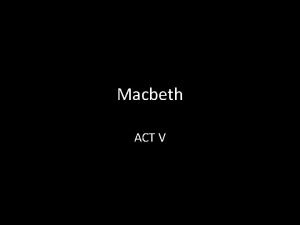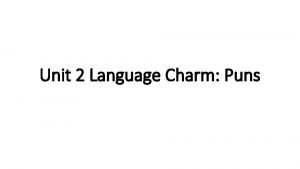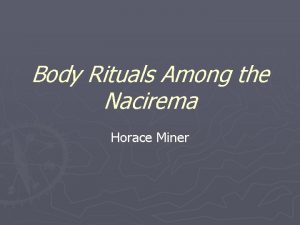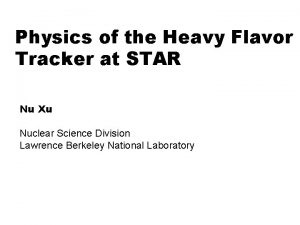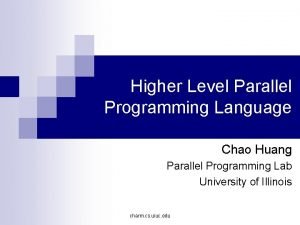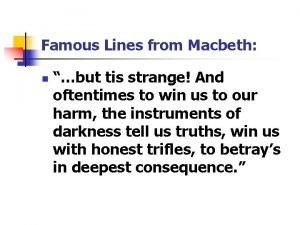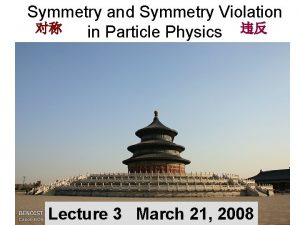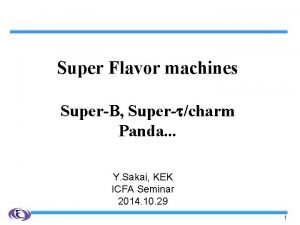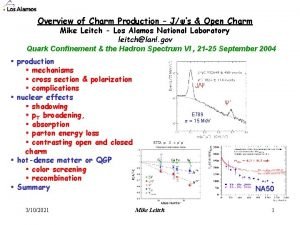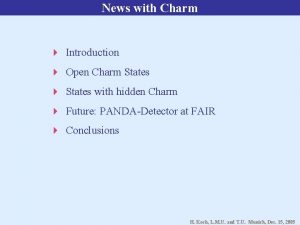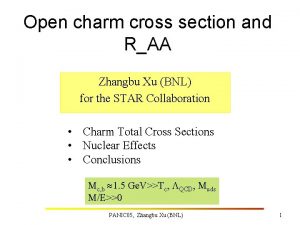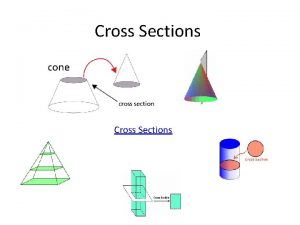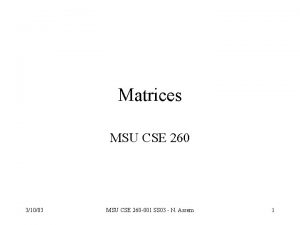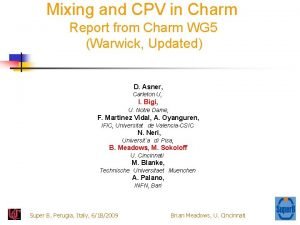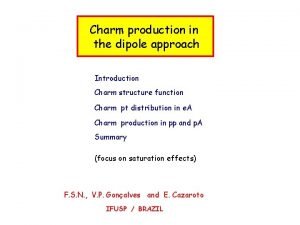Open Charm Cross Section Measurement at 4 260















- Slides: 15

Open Charm Cross Section Measurement at 4. 260 Ge. V Zhen Gao University of Science and Technology of China

Data Set • Data: 825. 7 pb-1@4. 260 Ge. V • MC: KKMC for D 0: D 0 D 0 bar , D 0*D 0*bar , D*D π , D*D* π , D+*D- (D+* --> D 0 π+), D+*D*KKMC for D±: D+D- , D+*D*- , D*Dπ (D+*-> π0/γ + D+), D*D*π KKMC for Ds±: Ds+Ds- , Ds+*Ds-* Inclusive MC at 4260 ** For example D 0 D 0 bar D 0 ->K-π+ and D 0 bar -> anything (50%) D 0 bar->K+π- and D 0 -> anything (50%)

Method (take D 0 as an example) 1. Get D 0/D 0 bar signal by tagging D 0/D 0 bar with Kπ mode. (D 0/D 0 bar + anything) + sideband 2. Get all the possible exclusive D 0/D 0 bar channels with MC. 3. Fit all the D 0(D 0 bar) channels together with sideband. Why not fit the recoil mass of each exclusive D 0(D 0 bar) channels? The statistical quantity for R scan data is not enough; Wrong combination while tagging D 0*

Dtag • Using Dtag. Tool: tag a D 0 with D 0 ->kpi mode (branching fraction: 3. 89%) • Signal region: |M-M(D 0)| < 15 Me. V Sideband region : 25 Me. V<|M-M(D 0)|<55 Me. V

Compare M(KPI) from Data and MC

p. D 0 and p. D 0 bar p. D 0: + p. D 0 bar: =

p. D 0 at 4. 260 Ge. V Bhabha Inclusive_DD Inclusive_qqbar Inclusive_had Dimu

In the low momentum region Angle between K and π in D 0 P(K)-P(π) in D 0 The events in the low momentum region may come from cosmic-ray !

Whether D(*)π exist? • Tag D 0 with Kπ mode • Tag D 0* with π0+D 0 • At least one π+ or π- from other tracks (not from D 0) • Mass of X in D 0(*) π(±) + X while the momentum of D 0 is less than 0. 5 Ge. V (D 0 is not from D 0(*))

Recoil mass Recoil(D 0 π+) Recoil(D 0* π+) Recoil(D 0 bar π) Recoil(D 0*bar π)

Conclusion • For multi-body processes(D(*)π) , DDπ signal is not obvious (does not exist or the cross section is very low) , but the D*Dπ and D*D* π signals are very clear. • Is there any other multi-body precesses? Such as D(*)ππ ?

Fitting Result MC can not describe data well? Any other components do not include?

Result of Ds+ and D+

Primary Cross section(1) Channel Number ε 1+δ Br. σ Ds. Ds 783± 120 0. 418 0. 846 0. 055 24. 4± 3. 74 Ds*Ds 1133± 215 0. 429 0. 847 0. 055 34. 3± 6. 5 Ds*Ds* 18393± 215 0. 442 0. 847 0. 055 540. 9± 6. 3 Channel Number ε 1+δ Br. σ D+D- 5509± 114 0. 496 0. 846 0. 095 83. 7± 1. 73 D+*D- 37030± 263 0. 503 0. 846 0. 095 • (1 -0. 677) 1717± 12 D+*D-* 7379± 185 0. 507 0. 846 0. 095 • (1 -0. 677) 340± 8. 2 DD*π 21016± 461 0. 510 0. 846 0. 095 • (1 -0. 677) 961. 2± 21 D*D*π 4597± 229 0. 488 0. 846 0. 095 • (1 -0. 677) 219. 7± 11

Primary Cross section(2) Channel Number ε 1+δ Br. σ D 0 D 0 bar 2438± 85 0. 551 0. 846 0. 039 81. 2± 2. 8 D 0*D 0 bar 22793± 274 0. 565 0. 846 0. 039 740. 4± 8. 9 D 0*bar 16138± 645 0. 584 0. 847 0. 039 1013. 1± 40 D*Dπ 30266± 412 0. 484 0. 846 0. 039 1147. 6± 15. 6 D*D*π 7165± 252 0. 520 0. 846 0. 039 252. 9± 8. 9
 영국 beis
영국 beis Charm and grace
Charm and grace Despair thy charm and let the angel
Despair thy charm and let the angel Winston churchill charisma
Winston churchill charisma Language
Language Forbid it lord that i should boast
Forbid it lord that i should boast Holy-mouth-men
Holy-mouth-men Tentaizu backtracking
Tentaizu backtracking Charm mesom
Charm mesom Charm programming language
Charm programming language Naught's had all's spent
Naught's had all's spent Weather tomorrow nnn
Weather tomorrow nnn Ffa charm
Ffa charm A charm quark has a charge of approximately
A charm quark has a charge of approximately Virtual production
Virtual production Charm
Charm


